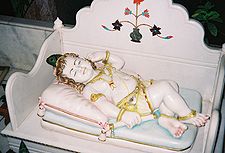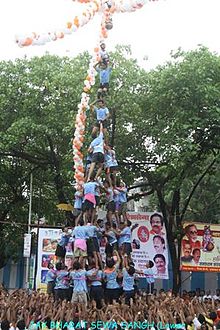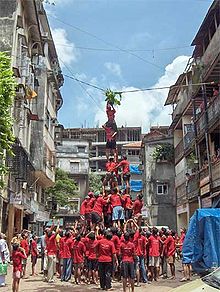- Krishna Janmashtami
-
Krishna Janmashtami 
Lord KrishnaAlso called Janmashtami / Dahi Handi Observed by Hindus Type Religious Date Bhadrapada, Ashtami 2010 date 1 September 2011 date 22 August (North India); 21 August (Kerala) Observances Fasting, praying Related to Krishna Krishna Janmashtami (Devanagari कृष्ण जन्माष्टमी kṛṣṇa janmāṣṭami), also known as Krishnashtami, Saatam Aatham, Gokulashtami, Ashtami Rohini, Srikrishna Jayanti, Sree Jayanthi or sometimes merely as Janmashtami, is a Hindu festival celebrating the birth of Krishna, an avatar of the god Vishnu.[1]
Krishna Janmashtami is observed on the Ashtami tithi, the eighth day of the dark half or Krishna Paksha of the month of Bhadrapada in the Hindu calendar, when the Rohini Nakshatra is ascendant. The festival always falls within mid-August to mid-September in the Gregorian calendar. In 2010, for example, the festival was celebrated on 2 September, and in 2011 on 22 August in North India and on 21 August in South Indian states like Kerala.[2]
Rasa lila, dramatic enactments of the life of Krishna, are a special feature in regions of Mathura and Vrindavan, and regions following Vaishnavism in Manipur. While the Rasa lila re-creates the flirtatious aspects of Krishna's youthful days, the Dahi Handi celebrate God's playful and mischievous side, where teams of young men form human pyramids to reach a high-hanging pot of butter and break it. This tradition, also known as uriadi, is a major event in Tamil Nadu on Gokulashtami.
Contents
In Maharashtra
Janmaashtami, popularly known in Mumbai and Pune as Dahi Handi, is celebrated with enormous zeal and enthusiasm. The handi is a clay pot filled with buttermilk that is positioned at a convenient height prior to the event. The topmost person on the human pyramid tries to break the handi by hitting it with a blunt object. Mostly nariyal (coconut) is preferred being a sign of purity, truth etc. in Hinduism. When that happens the buttermilk is spilled over the entire group, symbolizing their achievement through unity. Various handis are set up locally in several parts of the city, and groups of youngsters, called Govinda Pathaks, travel around in trucks trying to break as many handis as possible during the day.
Many such Govinda Pathaks compete with each other, especially for the handis that dole out hefty rewards. The event, in recent times, has gathered a political flavor, and it is common for political parties, and rich community groups to offer prizes amounting to lakhs of rupees.
Some of the most famous handis are at, Dadar, Lower Parel, Worli, Mazgaon, Lalbaug, Thane and Babu Genu, Mandai in Pune.[3]
Cash and gifts are offered for Govinda troops to participate; for over 4,000 handis in Mumbai, 2000 Govinda troops compete for the prizes.
In Manipur
Janmaashtami, popularly known in Manipur as Krishna Janma, is a significant festival celebrated at two temples in Imphal, the capital city of Manipur. The first festival is at the Govindaji temple and the second is at the International Society for Krishna Consciousness temple. Devotees of Lord Krishna gather mostly at the ISKCON temple.
Karnataka and Tamil Nadu
In Karnataka, Madhwas (Vaishnavas) (followers of saint Madhwacharya), Iyengars and Srivaishnavas, (followers of saint Ramanujacharya) and Smarthas (followers of Adi Shankara) make elaborate preparations for the festival. The idol of Lord Krishna is placed in a decorated mantapa. Bhakshanam (snacks and sweets in Sanskrit), that are specially prepared for the festival, are offered to Lord Krishna along with fruits and are considered to be his favourites. In some parts of Karnataka, chakli, avalakki and bellada panaka are prepared especially for the festival. Hand made avalakki is prepared in memory of Krishna's friend Sudhama. Legend has it that Sudhama had once offered avalakki to Krishna, as it was considered to be one of his favourite snacks. Gamaka vachana and other devotional activities are held in the evening.
Within the Sri Vaishnava(Iyengar) brahmins (who are mostly found in the Tamil Nadu state, and a considerable number in Karnataka as well), there have developed slight differences as to when to observe Sri Jayanti. There is also disagreement as to how exactly to observe the day. Should one observe upavAsa through the night, ceremonially breaking the fast the next morning, or should one eat immediately after the midnight pooja and aradhana? Broadly, there are five different opinions within the Sri Vaishnava tradition concerning this matter. The different sub-traditions are Pancaratra, Munitraya, Mannar, Tozhappar and Vaikhanasa. In a nutshell, the difference stems from lunar vs. solar month and whether to take sunrise or moonrise into consideration for determining jayanti.
Among Vadakalai Iyengars – The Pancaratra tradition is followed by Shri Ahobila Mutt, Munitraya tradition by Srirangam Srimadh Andavan Ashramam along with some other acharya purusha families, and the Mannar tradition is followed by Sri Parakala Mutt. It is named after one mannAr svAmi of unknown date who is the first extant authority arguing for this calculation. The tozhappar tradition is named after Sri Vaidika Sarvabhauma Swami, also known as Kidambi Thozhappar, who wrote a detailed text establishing the reasoning behind his tradition.[4]
The Thenkalai iyengars adhere to the Vaikhanasa tradition.In North India
In Uttar Pradesh where the lord was born in Mathura, his play ground Gokul and Vrindavan become more crowded and celebrations go up to a week. In Gujarat where the city Dwarka has Dwarkadhish temple celebrates it with pomp and joy.
In the eastern state of Orissa, around Puri and West Bengal in Nabadwip, people celebrate it with fasting and doing puja at midnight. Purana Pravachana from Bhagavata Purana are done from the 10th Skandha which deals with pasttimes of Lord Krishna. The next day is called Nanda Utsav or the joyous celebration of Nanda Maharaj and Yashoda Maharaani. On that day people break their fast and offer various cooked sweets during the early hour.
Outside India
Krishna Janmashtami is considered as Appearance of Lord Krishna, and the first ever elected government official in the world to issue Proclamations for celebrating Janmashtami is credited as Janet Napolitano [5][6][7] followed by others[8][9][10]
Janmastami vow
Sri Krishna taught us Karma Yoga. He strongly dictated in Gita that a man is bound to get the fruits of his actions. If he has done good actions/deeds throughout his life, he will get good results. The real meaning of Janamashtami vow is to become Karamyogi like Krishna. One should always follow the right path and never tolerate injustice. Karma yoga is action (karma) performed without expectations or thought of reward. This selfless service of karma yoga is the path by which the mind is most quickly purified and its limits transcended. The karma yogi works hard, both physically and mentally. He seeks to eliminate the ego and its attachments, to serve humanity without expecting rewards, and to see unity in diversity . This enables him to tune to the one underlying divine essence that dwells within all beings. Karma yoga is most suitable for people who have an active temperament. It involves working in the world and giving of oneself in a selfless way. The real essence is to become a selfless Karamyogi.
All advices and sermons Sri Krishna laid down in Gita, every word that he uttered, whether he was talking of Yoga or of stable genius (sthitaprajna), wisdom, always gave inspiration to fight and propelled them against the injustice. The perishability of the body, immortality of the soul, concentration of the mind, and undisturbed equanimity, calm and peaceful disposition of mind – all was to be described and explained in detail by Krishna so that Arjun, caught in the bewitching trap and completely at his wit's end should pick up his arms and pounce upon injustice, otherwise all these utterances were unnecessary right at the beginning of the war of Mahabharata, certainly not so important as to attract the attention of an magnanimous personality like Krishna.
"Dear devotees of Krishna, let us take a pledge today, let us make a resolution that we will not allow even advertently any blemish to defame the noble life of that spotless, innocent, virtuous and realized soul. Let us follow the footsteps of the ideals of great people." Following are the words of Krishna
- yad yad acarati shresthasthat devetaro janah
- sa yat pramam kurute lokas tadanuvartate
This is thus the preaching of life and the simple solution of finding happiness, peace and prosperity in life.[11]
References
- ^ "Sri Krishna Janamashtami celebrated in the city". The Hindu. August 24, 2008. http://www.hindu.com/2008/08/24/stories/2008082458410200.htm. Retrieved 2009-08-12.
- ^ Ashtami Rohini 2011 in Kerala – Sri Krishna Jayanti and Janmashtami
- ^ "Janmashtami celebrated with zeal, enthusiasm". Mid Day. August 24, 2008. http://www.mid-day.com/news/2008/aug/240808-janmashtami-celebrated.htm. Retrieved 2009-08-12.
- ^ SriJayanthi-Janmasthami. Scribd.com (2008-08-23). Retrieved on 2011-11-10.
- ^ Blog Archive » The Governor of Arizona issues Proclamation for Sri Krishna Janmashtami. Dandavats. Retrieved on 2011-11-10.
- ^ Blog Archive » ISKCON Devotees greeted by Arizona Governor Janet Napolitano during National Prayer. Dandavats (2008-05-09). Retrieved on 2011-11-10.
- ^ Blog Archive » Arizona Governor’s Sri Krishna Janmashtami Proclamation 2008. Dandavats. Retrieved on 2011-11-10.
- ^ Houston ISKCON Silver Anni Festival Proclamation. YouTube (2011-08-21). Retrieved on 2011-11-10.
- ^ Iskcon Sydney. Iskcon.com.au. Retrieved on 2011-11-10.
- ^ Governor’s Executive Orders/Proclamations. Arizona Administrative Register / Secretary of State. Volume 15, Issue 32, Page 1312. August 7, 2009
- ^ Lord Krishna – an enlightening personality. Satyavidya.org (2009-12-31). Retrieved on 2011-11-10.
External links
- Krishna Janamashtami celebrations at Shangharsha Thane on 22nd August 2011.
- Udupi Shri Krishna Janmashtami Celebration procedure
- Janamashtami in Vrindavan, Janamashtami celebrations at Shri Banke Bihari Temple, the most popular temple in Braj.
- Shri Krishna Janmashtami, dedicated and comprehensive site with details on celebrations, customs and more.
- Dwarka Jagad Mandir, in depth information about Dwarka and Krishna Janmasthami
- All about Lord Krishna and Janmashtami, His Birthday
- Pictures of Krishna Janmashtami celebrations on boston.com
Krishna Forms Worship Holy sites Texts See also Hinduism • Avatar • Svayam Bhagavan • Vishnu • Radha • Rukmini • Satyabhama • Krishna images at WikiCommonsFestivals in the Hindu calendar Major festivals - Pongal (Makar Sankranti)
- Holi
- Rama Navami
- Krishna Janmashtami
- Maha Shivaratri
- Onam
- Ganesh Chaturthi
- Navratri (Mysore Dasara – Durga Puja – Vijayadashami)
- Diwali (Bhau-Beej)
- Chhath

Regional New Year - Gudi Padwa (Marathi, Konkani)
- Ugadi (Telugu, Kannada)
- Cheti Chand (Sindhi)
- Bihu (Assamese)
- Vaisakhi (Punjabi)
- Vishuva Sankranti (Oriya)
- Pohela Boishakh (Bengali)
- Puthandu (Tamil)
- Vishu (Malayalee)
Holy days Holy periods Categories:- August observances
- Festivals in India
- Hindu festivals
- Hindu holy days
- Krishna
- Vaishnavism
- Human towers
Wikimedia Foundation. 2010.


